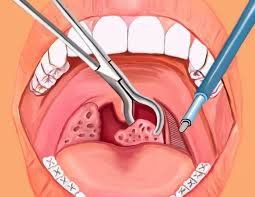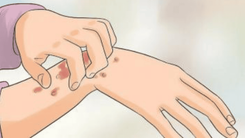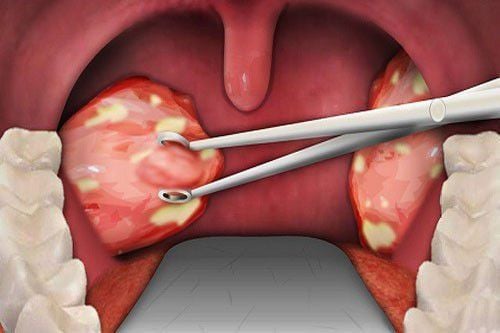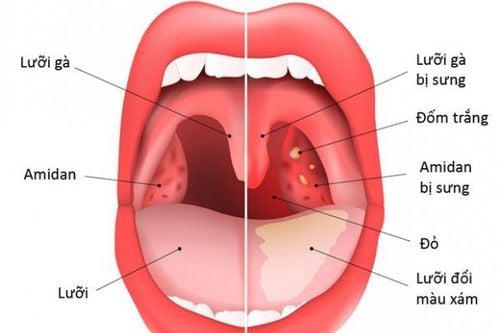Article by MSc, MD Mai Vien Phuong - Department of Examination & Internal Medicine - Vinmec Central Park International General Hospital
Mild bleeding after a tonsillectomy (tonsillectomy) may not be a cause for concern, but in some cases, bleeding can be a sign of a medical emergency. If you or your child has recently had a tonsillectomy, it is important to understand when bleeding means you should call your doctor and when you should go to the emergency room.
1. Why do you bleed after a tonsillectomy?
You will most likely experience a small amount of bleeding immediately after surgery or about a week later when the scab from the surgery falls off. However, bleeding can occur at any time during the recovery process.
For this reason, you or your child should not leave your home or go anywhere for the first two weeks after surgery where you cannot quickly get to a doctor.
According to the Mayo Clinic, it is common to see small spots of blood from your nose or in your saliva after a tonsillectomy, but bright red blood is a cause for concern. It could indicate a serious complication called post-tonsillectomy hemorrhage.
Bleeding is rare, occurring in only about 3.5% of surgeries, and is more common in adults than children.
2. Types of Bleeding After Tonsillectomy
2.1. Primary Post-Tonsillectomy Hemorrhage
Hemorrhage is another word for significant bleeding. If bleeding occurs within 24 hours of a tonsillectomy, it is called primary post-tonsillectomy hemorrhage.
Five major arteries supply blood to the tonsils. If the tissue around the tonsils does not compress and form a scab, these arteries can continue to bleed. In rare cases, bleeding can be fatal.
Early signs of bleeding right after a tonsillectomy include:
- Bleeding from the mouth or nose
- Frequent swallowing
- Vomiting bright red or dark brown blood

2.2. Secondary post-tonsillectomy hemorrhage
Five to 10 days after a tonsillectomy, your scab will begin to fall off. This is a completely normal process and may cause a small amount of bleeding. Crusting bleeding is a type of secondary post-tonsillectomy hemorrhage because it occurs more than 24 hours after surgery.
You will see dried blood spots in your saliva as the scab falls off. Bleeding can also occur if the scab falls off too soon. The scab is more likely to fall off early if you are dehydrated.
If you have bleeding from your mouth sooner than five days after surgery, contact your doctor immediately.
3. What to do if you see blood?
Small amounts of dark or dried blood in your saliva or vomit are probably not a cause for concern. Continue to drink fluids and rest.
Otherwise, passing bright red blood in the days after a tonsillectomy is a cause for concern. If you are bleeding from your mouth or nose and the bleeding does not stop, stay calm. Gently rinse your mouth with cold water and keep your head elevated. If the bleeding continues, seek immediate medical attention.
If your child is bleeding from the throat that is flowing rapidly, turn your child onto his or her side to make sure the bleeding does not interfere with breathing, and then call 911.
When should you call your doctor? After surgery, call your doctor if you experience any of the following:
- Bright red blood from your nose or mouth
- Vomiting bright red blood
- Fever higher than 102.4°F (39°C)
- Unable to eat or drink anything for more than 24 hours
4. When should you call emergency?
Adults: According to a 2013 study, adults are more likely than children to experience bleeding and pain after a tonsillectomy. The study specifically looked at the cryotherapy tonsillectomy procedure.
Call emergency services if you are experiencing:
- Severe vomiting or vomiting up blood clots
- A sudden increase in bleeding
- Continuous bleeding
- Difficulty breathing
- For children
If your child develops a rash or diarrhea, call your doctor. If you see blood clots, streaks of bright red blood in your child's vomit or saliva, or your child is vomiting blood, call 911, the hospital's emergency number, or go to the emergency room immediately.
Other reasons to go to the emergency room for children include:
- Inability to keep fluids down for several hours
- Difficulty breathing
5. Are there any other complications after a tonsillectomy?
Most people recover from a tonsillectomy without any problems; however, there are some complications you should watch for. Most complications require a visit to the doctor or the emergency room.
- Fever: A low-grade fever of up to 100.4°F (38°C) is common in the first three days after surgery. A fever higher than 100.4°F (38°C) may be a sign of infection. Call your doctor or your child's doctor if the fever gets this high.
- Infection: As with most surgeries, tonsillectomy carries a risk of infection. Your doctor may prescribe antibiotics after surgery to help prevent infection.
- Pain: Everyone has a sore throat and ear after a tonsillectomy. The pain may be worse about three or four days after surgery and improve over a few days.
- Nausea and vomiting: You may have nausea and vomiting for the first 24 hours after surgery because of the anesthesia. You may see small amounts of blood in your vomit. Nausea and vomiting usually go away after the anesthesia wears off.
Vomiting can cause dehydration. If your child shows signs of dehydration, call your doctor.Signs of dehydration in a baby or young child include:
- Dark urine
- No urine for more than eight hours
- Crying without tears
- Cracked lips
- Difficulty breathing: A swollen throat can make it hard to breathe. However, if breathing becomes difficult, you should call your doctor.

6. Symptoms after tonsillectomy
You can expect the following to happen during your recovery:
- Days 1-2: You will probably feel very tired and groggy. Your throat will feel sore and swollen. Rest is essential during this time. You can take acetaminophen, Paracetamol to help relieve pain or reduce fever. Do not take aspirin or any non-steroidal anti-inflammatory drugs (NSAIDs) such as ibuprofen (Motrin, Advil) as this can increase the risk of bleeding. Make sure to drink plenty of fluids and avoid solid foods. Cold foods such as popsicles and ice cream can be very soothing. If your doctor prescribes antibiotics, take them as directed.
- Days 3-5: Your sore throat may get worse on days three to five. You should continue to rest, drink plenty of fluids, and eat soft foods. Applying ice to your neck (ice collar) may help relieve pain. You should continue to take antibiotics as prescribed by your doctor until the prescription is finished.
- Days 6–10: As the scab in your incision is completely formed and peels off, you may experience some bleeding. Small streaks of red blood in your saliva are considered normal. Your pain should gradually decrease over time.
- Days 10: and beyond You should begin to feel normal again, although you may have a sore throat that will gradually go away. You can return to school or work after you have resumed eating normally.
7. How long does it take to recover from a tonsillectomy?
As with any surgery, recovery times can vary greatly from person to person.
- Children: Children may recover more quickly than adults. Some children can return to school within ten days, but others may take up to 14 days before they are ready.
- Adults: Most adults recover fully within two weeks of a tonsillectomy. However, adults may be at higher risk for complications than children. Adults may also experience more pain during recovery, which can lead to a longer recovery time. After a tonsillectomy, it is typical to see dark spots of blood in your saliva or streaks of blood in your vomit. A small amount of bleeding may also occur about a week after surgery as your scab matures and falls off. This is not a cause for concern. You should call your doctor if the bleeding is bright red, severe, does not stop, or if you have a high fever or vomit a lot. Drinking plenty of fluids in the first few days after surgery is the best thing you can do to reduce pain and help prevent bleeding complications.
Currently, the new method of cutting tonsils with the Coblator system, using a plasma knife, has been applied in recent years and has shown high efficiency and safety. The plasma knife is created from high-frequency electromagnetic waves, called radio waves, the energy from these radio waves will create a conductive cloud surrounding the cutting device, allowing cutting and destroying cell tissue at a temperature of only 60 to 70 degrees Celsius, much lower than electric knives or lasers (200 to 400 degrees Celsius).
Vinmec International General Hospital is currently using the latest generation of Coblator machines using a multifunctional probe that can both cut with high-frequency waves (acting as a plasma knife) and irrigate with water to cool down and suck up debris. In addition, radio waves also block small blood vessels, which is effective in stopping bleeding during surgery.
Thanks to the limited damage to surrounding tissues, less pain, and significantly reduced bleeding complications after surgery, tonsillectomy is no longer a fear for many people.
To make an appointment at the hospital, please dial the HOTLINE or make an appointment directly HERE. Download and make an automatic appointment on the MyVinmec app to manage, track schedules and make appointments anytime, anywhere right on the application.
Reference article source: Ersözlü T, et al. (2013). Comparison of pediatric and adult tonsillectomies performed by thermal welding system; Hussain S, et al. (2017). Time between first and second post-tonsillectomy bleeds; Mayo Clinic Staff. (2018). Tonsillectomy













